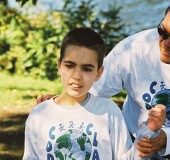
THURSDAY, April 26 (HealthDay News) — From the time she was a toddler, Abby Mahoney’s parents knew she was different. She could name 200 dinosaurs by age 3, and offered up detailed theories about why they became extinct.
Abby also had difficulty making friends. And teachers didn’t understand why an intelligent child would crawl under her desk while the other kids sat in a circle reading a book.
“She talked like a little professor. A lot of people remarked how amazing it was she was so brilliant,” said Abby’s mom, Patricia. “It took us awhile to figure out that the reason she had difficulty relating to her peers was that she had Asperger’s.”
Children with Asperger’s syndrome, an autism spectrum disorder, can be highly intelligent but have trouble reading social cues, may display repetitive behaviors or restricted interests, and often have an intense need to adhere to certain schedules or rituals.
As she got older, Abby’s inability to fit in made her a target for bullying. When they weren’t ignoring her, other kids in her Baltimore school laughed at her or teased her relentlessly.
“It’s really painful to watch your child being hurt in this way,” Patricia Mahoney said. “For kids with Asperger’s, it’s part of their disability to not be able to navigate the social world of typical people, so their disability is being preyed upon.”
Abby is far from alone. About one in 88 U.S. children is estimated to have autism, a developmental disorder that can cause mild to severe difficulties with communication and social interaction. And nearly two-thirds of U.S children with an autism spectrum disorder have been bullied at some point — according to a recent survey of nearly 1,200 parents by the Kennedy Krieger Institute’s Interactive Autism Network.
Just this week, the father of an autistic boy in New Jersey released a recording of what the father said was a teacher and an aide bullying his 10-year-old son to the point of tears, according to USA Today. The father said he decided to place a digital tape recorder on his son before going to school after school officials said the boy had suddenly started displaying uncharacteristic behavioral problems. After taking the recording to school officials, the aide was fired and the teacher was reassigned, the newspaper reported.
“It’s a huge issue for many families,” said Connie Anderson, community scientific liaison for the Interactive Autism Network. “Part of the reason the children are so vulnerable is that the heart of autism is a social disability. It’s really hard for them to read the social world, to interpret what’s going on, to make an appropriate response, something most people do naturally.”
Although bullying occurs in every grade, it peaks in grades 5 through 8, and it takes many forms, the survey found. Many children were teased or made fun of; ignored or left out of things on purpose; called bad names; or pushed, shoved, hit, slapped or kicked. Experts noted that school is already hard for these kids, and bullying can make it that much more difficult for them to get what they need out of school. That includes academics, but also being in an environment where they can learn more about how to socialize.
Some parents said their children were purposefully provoked into a meltdown. In Abby’s case, other kids would hide an item that was important to her, leading Abby to become increasingly upset until she fell apart, her mom said.
And some kids with autism are themselves labeled as bullies, even though experts believe autistic kids aren’t intentionally mean, Anderson said.
“What we think is happening is that other kids are pushing their buttons, and they’re having aggressive outbursts or temper tantrums,” she said.
Children with an autism spectrum disorder also don’t know how to tell “social lies.” The autistic child might come right out and say, “I don’t like you and I don’t want to sit by you,” Anderson said.
What’s doubly difficult for parents is their own frustration with their child’s behavior, Mahoney said. “I was angry at the bullies, but also frustrated and exasperated with her at her inability to cope,” Mahoney said.
Kids with high-functioning autism or Asperger’s are twice as likely as children with more severe autism to be bullied, the survey found. This may be because they are often in regular classes; it could be because it’s socially unacceptable even among youth to tease an obviously disabled child, said Katherine Thweatt, an assistant professor in the department of communication studies at West Virginia Wesleyan College.
Whereas children get told not to pick on someone clearly handicapped, what about people with mild differences? “Kids aren’t told, ‘Don’t tease people because they stand too close to you, or because they talk to you for too long,'” Thweatt said.
Anderson urges parents to keep close tabs on what happens during their child’s school day — to ask an aide, if the child has one, or the child. Without prompting, kids may not share what’s happening to them. Even the numbers in the survey may be an underestimate, Anderson said.
Eventually, the teasing led Mahoney to quit her job and home-school Abby for two years. Recently, she enrolled Abby, now 13, in a private school for kids with communication disorders such as autism.
“Even though some days are a struggle there, she is going to be in a supportive environment where she is not facing the teasing,” Mahoney said. “Kids can be so cruel, even to normal kids. But I know that she is safe there, and she can learn to help herself deal with those challenges.”
Mahoney urged other parents dealing with a similar situation to seek out help and support from autism resources.
“With support and intervention, these kids are amazing, a great gift,” Mahoney said.
More information
For more on bullying and children with special needs, visit the Bully Project.

